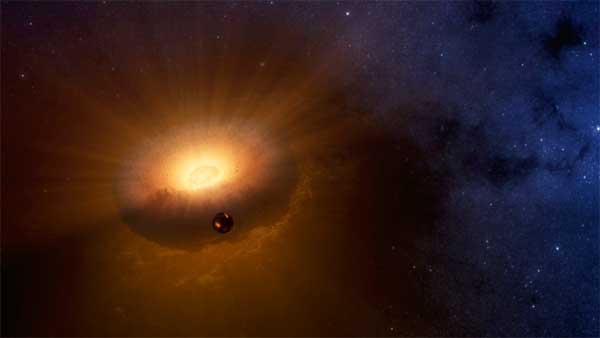
The Planet K2-18b May Not Be Habitable After All
New research suggests Exoplanet K2-18b may actually be a gas-rich planet with no habitable surface instead of a habitable water world.

JWST Photographs Possible Giant Planets Around White Dwarfs
JWST has directly imaged two giant exoplanets orbiting white dwarf stars. This discovery may reveal the fate of our solar system.

Hubble Reveals Possible Water-Vapor World
New Hubble Space Telescope observations reveal the warm sub-Neptune GJ 9827d might have a steamy atmosphere.

Did Webb Detect an Atmosphere on Hot Super-Earth 55 Cancri e?
New Webb data suggests that the hot super-Earth 55 Cancri e has a thick atmosphere, perhaps maintained by the planet's magma ocean.

Unexplained Auroras Found on a Lonely Brown Dwarf
James Webb Space Telescope observations of a faint, giant world have revealed the signature of aurorae — even though the world has no star.

Doubt Cast on Exomoon Candidates
Exomoon candidates are tantalizing but, according to new research, perhaps unfounded.

Six Sub-Neptunes Discovered 100 Light-Years Away
Astronomers have uncovered six sub-Neptune exoplanets dancing in lock-step around the same distant star, shedding light on their formation.

Webb Telescope Peers into Puffy Planet with Clouds of Sand
A mere 200 light-years away, there's a planet with the density of styrofoam and clouds of sand. How did it get so weird?

Webb Shows Planets Really Do Start with Pebbles
New observations have turned up evidence that icy pebbles deliver the water to inner regions of planet-forming disks.

Two Worlds Have Ended in a Planetary Collision — and a New One Has Begun
A star's sudden brightening and, two years later, its sudden dimming point to a cataclysmic collision between two large worlds.

How Did Two Hot and Super-dense Neptunes Form?
Astronomers have discovered two Neptune-size planets that are denser than rock and in searingly close orbits to their star. How did these odd worlds form?

Hubble, Webb Data Hint at Ocean Worlds
Data coming from the Webb and Hubble space telescopes suggests two exoplanets might be water worlds. But the evidence isn’t yet definitive.

Webb Views the Ring Nebula and Earendel in a New Light
This week, James Webb Space Telescope reveals new details in the Ring Nebula and shows that the most distant known star isn't alone. Meanwhile, patient astronomers have collected 17 years' worth of images of the super-Jupiter Beta Pictoris b.

Astronomy in Pictures: The Birth of Stars and Planets
Images capture the birth of stars and planets in multiple results from space- and ground-based telescopes.

This Planet Might Have a Sibling Sharing Its Orbit
Astronomers have spotted the first solid evidence for a planetary Trojan body forming in another system outside our own.

Exoplanet News: No Air on Venus Twin, Young Jupiter Discovery
Astronomers have discovered Jupiter's younger sibling in a system 88 light-years away. Meanwhile, only 40 light-years away, a Venus-size world turns out to be airless (or nearly so).

Mini-Neptune Reveals (Some of) Its Secrets
James Webb Space Telescope observations offer a new window inside the atmosphere of the secretive sub-Neptune GJ 1214b.

The James Webb Space Telescope Reveals Fomalhaut's Disk In Unprecedented Detail
Continuing its run of ground-breaking discoveries, the James Webb Space Telescope has snapped the clearest images yet of the dusty disk around the young star Fomalhaut.

Star Caught Swallowing a Planet
For the first time, astronomers have witnessed a star eat an exoplanet.

Where to Look for Life: Homing in on the Habitable Zone
Scientists are refining the definition of the habitable zone in an effort to aid future efforts at finding life.
